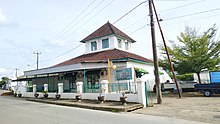
The Goripalayam Mosque is a large mosque in Goripalayam containing two graves (tombs) of Sultans of Yemen namely Khaja Syed Sultan Alauddin Badusha Razi and Khaja Syed Sulthan Shamsuddin of the Madurai Sultanate. There is also one invisible grave of Khaja Syed Sultan Habibuddin Razi who is also known as Ghaibi Sulthan who came to India to spread Islam. Its dome is 70 feet (21 m) in diameter and 20 feet (6.1 m) in height and made of a single block of stone which was brought from the Azhaga Hills. It is said that it was built by Thirumalai Nayak for his Muslim subjects.

Masjid Tanah is a town and parliamentary constituency in northwestern Malacca, Malaysia, bordering Negeri Sembilan across the Linggi River.
Sunan Kudus, founder of Kudus, is one of the Wali Sanga, of Java, Indonesia to whom the propagation of Islam amongst the Javanese is attributed.

The Banten Sultanate was a Bantenese Islamic trading kingdom founded in the 16th century and centred in Banten, a port city on the northwest coast of Java; the contemporary English name of both was Bantam. It is said to have been founded by Sunan Gunungjati, who had previously founded Cirebon.

The history of the arrival of Islam in Indonesia is somewhat unclear. One theory states that Islam arrived directly from Arabia as early as the 9th century, during the time of the Umayyad and Abbasid caliphates. Another theory credits Sufi travelers for bringing Islam in the 12th or 13th century, either from Gujarat in India or from Persia. Before the archipelago's conversion to Islam, the predominant religions in Indonesia were Hinduism and Buddhism.

Abadin Tadia Tjoessoep, more commonly known as Sheikh Yusuf or Sheik Joseph, was an Indonesian Muslim of noble Makassar descent. He was also known as Muhammad Yusuf al-Maqassari or Tuanta Salamaka ri Gowa. In 1693 he was exiled to the Cape of Good Hope, South Africa, which resulted in his establishing Islam in the Cape.

Sultan Hasanuddin (Sultan Hasanuddin Tumenanga Ri Balla Pangkana; was the 16th Ruler of The Sultanate of Gowa as Sombaya Ri Gowa XVI from 1653 to 1669. He was proclaimed as Indonesian National Hero on 6 November 1973. The Dutch called Sultan Hasanuddin "the Rooster of the East" as he was described as aggressive in battle.

The Sultanate of Bima, officially known as The Settlements and Lands of Mbojo, alternatively the Kingdom of Bima was a Muslim state in the eastern part of Sumbawa in Indonesia, at the site of the present-day regency of Bima. It was a regionally important polity which formed the eastern limit of Islam in this part of Indonesia and developed an elite culture inspired by Makassarese and Malay models. Bima was subjected to indirect colonial rule from 1908 to 1949 and ceased to be a sultanate in 1958.

The Makassar people or Makassarese are an ethnic group that inhabits the southern part of the South Peninsula, Sulawesi in Indonesia. They live around Makassar, the capital city of the province of South Sulawesi, as well as the Konjo highlands, the coastal areas, and the Selayar and Spermonde islands. They speak Makassarese, which is closely related to Buginese, and also a Malay creole called Makassar Malay.

Raden Patah, also known as Jin Bun was the first sultan of the Demak Sultanate. Ascending to the throne in 1475, he remained a vassal of the Majapahit Empire until 1478. Raden Patah took the title Panembahan Jimbun after legitimizing the Sultanate of Demak as the successor state to the Majapahit Empire, with the Wali Sanga appointing him the Sultan of Demak.
Universitas Islam Negeri Alauddin is a university located in Makasar, South Sulawesi. The name Alauddin originates from the name of the first king of the Gowa Sultanate who converted to Islam, changed his name to Alauddin and made Islam as the sultanate's official religion.

The Sultanate of Gowa was one of the great kingdoms in the history of Indonesia and the most successful kingdom in the South Sulawesi region. People of this kingdom come from the Makassar tribe who lived in the south end and the west coast of southern Sulawesi.

Somba Opu is a district (kecamatan) located in the Gowa Regency, South Sulawesi, Indonesia, and is part of the Greater Makassar area. Somba Opu is one of 18 districts in Gowa Regency. The administrative capital of Gowa Regency, "Sungguminasa", is located in this district and this is the largest regency capital or 2nd largest town in South Sulawesi. A suburb to Makassar, the district is a relatively urbanized area, and can also be called as the city's bedroom community.

Mosque architecture in Indonesia refers to the architectural traditions of mosques built in the archipelago of Indonesia. Initial forms of the mosque, for example, were predominantly built in the vernacular Indonesian architectural style mixed with Hindu, Buddhist or Chinese architectural elements, and notably didn't equip orthodox form of Islamic architectural elements such as dome and minaret. Vernacular architectural style varies depending on the island and region.

Palopo Old Mosque is a historical mosque in South Sulawesi, Indonesia. Constructed in 1604, the mosque is one of the oldest mosques in the archipelago. The mosque is noted for its unique vernacular architectural style.
The Nurul Hilal Dato Tiro Mosque, formerly known as Hila-Hila Mosque, is a historical mosque in South Sulawesi, Indonesia. Constructed in 1605, the mosque is one of the oldest mosques in the archipelago.

Gang Bengkok Old Mosque, is a mosque located in Medan, North Sumatra, Indonesia. The Gang Bengkok Old Mosque is precisely located on Jalan Mesjid, Kesawan, West Medan Districy, Medan. Gang Bengkok Old Mosque was built by a merchant and Kapitan from Guangdong, China, named Tjong A Fie. This mosque was first built in 1885, but the renovation was completed in 1889. This mosque was then handed over by Tjong A Fie to the Deli Sultanate, namely during the reign of Sultan Deli Sultan Ma'mun Al Rashid.















